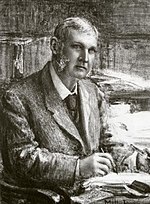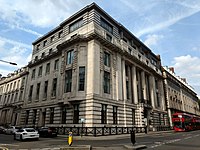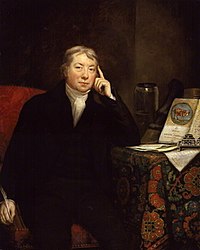Jenner Medal of the Royal Society of Medicine
 From Wikipedia - Reading time: 10 min
From Wikipedia - Reading time: 10 min
| Jenner Medal of the Royal Society of Medicine | |
|---|---|
|
Royal Society of Medicine (top) and Edward Jenner by James Northcote (below) | |
| Awarded for | Contributions to epidemiology and public health |
| Date | 1896 |
| Location | London |
| Country | United Kingdom |
| Presented by | Royal Society of Medicine at the recommendation of the Epidemiology and Public Health Section |
| Hosted by | Royal Society of Medicine, London |
| Formerly called | Jenner Memorial Medal of the Epidemiological Society of London |
| Motto | Venienti Occurrite Morbo |
| Highlights | |
| First recipient | Sir William Henry Power (1898) |
| Other anniversaries | Leonard Colebrook (1962 centenary of Sydney Copeman's birth) |
| Last known recipient | Sir Michael G. Marmot (2010) |
The Jenner Medal of the Royal Society of Medicine, formerly known as the Jenner Memorial Medal or the Jenner Medal of the Epidemiological Society of London, is awarded from time to time by the Royal Society of Medicine (RSM), London, at the recommendation of its Epidemiology and Public Health Section, to individuals who have undertaken distinguished work in epidemiological research or made significant contributions in preventing and controlling epidemic disease. It is named in honour of Edward Jenner's discovery of a means of smallpox vaccination. The first Medal was awarded in 1898, presented by Sir Patrick Manson to Sir William Henry Power, the then Medical Officer of Health for London.
The Medal was designed in bronze by Allan Wyon. The date of the award and recipient's name is engraved on the rim. A three-quarter face of Jenner is engraved on the obverse, and on the reverse is depicted a globe. The original by-laws, published in 1898, stated that the medal should commonly be called the "Jenner Medal", the awardee not be confined to only the British, and that the Epidemiological Society Council would determine when and who receives it. The regulations were revised in 1951, with the recommendation that the Medal be awarded not more frequently than once in five years.
Foundation
[edit]The Jenner Medal was founded on 15 May 1896 at a meeting of the Epidemiological Society of London (1850–1907), during the presidency of Sir Shirley Murphy, to commemorate the centenary of Edward Jenner’s discovery of a means of smallpox vaccination.[1][2][a]
The founding committee was made up of Murphy, Sir Richard Thorne Thorne, Theodore Preston, Frank Clemow, R. D. Sweeting, Bulstrode and Coupland.[1] Appeals for funds were made through medical journals.[1][5] Subscribers included the Epidemiological Society, Thorne, Murphy, John C. McVail, Thomas H. Wakley, Sir James Donnet, Sir William Broadbent, Robert Barnes, Andrew Davidson, Sir Edwin Saunders, Philip Pye-Smith, Joseph Frank Payne, Sir John Simon, and Sir James Paget.[1] From outside the UK, subscribers included Kalman Muller from Budapest, Prospero Sonsino from Pisa, Rudolph H. Saltet from Amsterdam, and Joseph D. Tholozan from Teheran.[1]
Design
[edit]

The medal, a coin, was designed in bronze by Allan Wyon.[5] The date of the award and recipient's name is engraved on the rim.[2] A three-quarter face of Jenner is engraved on the obverse, and accompanied are the words:
Edward Jenner, M.D., F.R.S, born 1749, died 1823[2]
The symbol of the Epidemiological Society, the Earth, is depicted on the reverse.[2][5] Around the circumference are the words:
Centenary of Vaccination Celebrated 1896. For Work of Great Merit. Epidemiological Society of London. Venienti Occurrite Morbo[2]
Regulations
[edit]The by-laws, published in 1898, stated that the medal should commonly be called the "Jenner Medal", the awardee not be confined to only the British, and that the Epidemiological Society Council, via its Jenner Medal sub-committee consisting of its president, treasurer and honorary secretaries, would determine when and who receives it.[6]
The medal was re-cast by Wyon following the merger of the Epidemiological Society with the Royal Medical and Chirurgical Society of London in 1907, when it became the Section of Epidemiology and State Medicine of the RSM.[5][7][b] The new Epidemiological Section then made their recommendation to the RSM Council, who were to bestow the Medal.[2][8]
In 1951, a sub-committee was established to revise the by-laws, following the eleventh award to Glover.[9] The Jenner Medal sub-committee consisted of Robert Cruickshank, then the Section president, W. Charles Cockburn and Ian Taylor, the two honorary secretaries, and Glover.[9] After considering the notability of the former awardees, they recommended that the Medal be awarded not more frequently than once in five years, and that it be a standing item on the agenda of the Section Council meeting preceding their annual meeting each year.[9][c] Awarding it too often was seen to diminish its value, and that it had not generally been awarded regularly highlighted that the Section Council were not always aware of its details.[9]
Awards
[edit]The purpose of the award is to reward an individual for significant work in epidemiology or contributions in preventing and controlling epidemic disease.[8] The Medal was first awarded on 24 June 1898 to Sir William Henry Power, who was the then Medical Officer of Health for London, and had chaired the Royal Commission on Tuberculosis.[5][6][10] It was subsequently awarded to Charles Louis Alphonse Laveran, for discovering the malaria parasite, and then Sir Patrick Manson, for showing that it was carried by a mosquito.[5]
In 1923, the Medal featured at a RSM event to commemorate the centenary of Jenner's death.[2] There, delegates passed anti-vaccinationists before entering the building.[2] When James Alison Glover won the eleventh Medal in 1951, he mentioned that he had been acquainted with seven of the previous ten recipients.[11] The 1962 award to Leonard Colebrook was timed with the centenary of the birth of Sidney Monckton Copeman, who had won it himself 37 years earlier.[12] Donald Henderson received the Medal in 1996, the year of the Jenner's discovery's bicentenary.[5][13]
Recipients
[edit]| No. | Year | Recipient | Nationality | Notes Ref. | Image |
|---|---|---|---|---|---|
| 1 | 1898 | Sir William Henry Power (1842–1916) |
Power formulated the theory of airborne transmission of smallpox after observing the smallpox epidemics of 1871–1872 and 1881 in London.[10][14][15]
Presented by Manson.[7] |

| |
| 2 | 1902 | Charles Louis Alphonse Laveran (1845–1922) |
Known for his discovery of the malaria parasite.[2][16] | 
| |
| 3 | 1912 | Sir Patrick Manson (1844–1922) |
Presented on 22 March 1912 by the Epidemiological Section president Theodore Thomson, the Medal was awarded to Manson for his discovery of the mosquito as a carrier of the malaria parasite; mosquito-malaria theory.[2][17] | 
| |
| 4 | 1921 | Sir Shirley Forster Murphy (1841–1923) |
A former president of the Epidemiological Society, Murphy played a significant role in reducing deaths of babies in London.[2][18] | ||
| 5 | 1922 | John Christie McVail (1849–1926) |
[2][19] | ||
| 1925 | Sidney Monckton Copeman (1862–1947) |
At the time, Copeman was Medical Officer to the Ministry of Health, and the following year he became the Epidemiology Section's president.[5][12] | 
| ||
| Major Greenwood (1880–1949) |
[11][d] | 
| |||
| Before 1933 | Thomas Henry Craig Stevenson (1870–1932) |
[11][21] | |||
| 9 | 1935 | Sir George Seaton Buchanan (1869–1936) |
Presented on 25 January 1935.[22][23][11][24][25] | 
| |
| 10 | 1938 | Arthur Newsholme (1857–1943) |
[26][27] | 
| |
| 11 | 1951 | James Alison Glover (1874–1963) |
Known as the "good friend of the private soldier", Glover was known for his work on carrier rates of meningococcus and overcrowding, and showing that cases of rheumatism occurred after outbreaks of sore throats caused by Streptococcus pyogenes.[11][28][29]
Presented by the RSM president Lord Webb-Johnson.[11] |
||
| 12 | 1953 | Alexander Thomas Glenny (1882–1965) |
Contributions to diphtheria immunisation[5] | 
| |
| 13 | 1956 | Percy Stocks (1889–1974) |
Presented by Sir Clement Price Thomas on 16 November 1956.[30][31][32][33] | ||
| 14 | 1962 | Leonard Colebrook (1883–1967) |
Presented in October 1962 by Lord Adrian[12][34] | 
| |
| 15 | 1965 | Sir Austin Bradford Hill (1897–1991) |
[8][35] | 
| |
| 16 | 1975 | Sir Graham Wilson (1895–1987) |
Worked on the quality of pasteurization of milk, co-authored a major textbook on bacteriology, and established the Public Health Laboratory Service.[8][36] | 
| |
| 17 | 1979 | Alexander D Langmuir (1910–1993) |
Awarded on 14 May 1979.[37][38] | 
| |
| 18 | 1981 | Richard Doll (1912–2005) |
Studies on the epidemiology of cancer[5]
Presented by Walter W. Holland on 9 July 1979.[8] |

| |
| 19 | 1984 | Karel Raška (1909–1987) |
He worked towards worldwide eradication of smallpox.[39]
Presented by J. P. Crowdy[40] |

| |
| 20 | 1987 | J. N. Morris (1910–2009) |
[41] | ||
| 21 | 1991 | Spence Galbraith (1927–2008) |
Founded the PHLS Communicable Disease Surveillance Centre (CDSC).[42][43] | ||
| 1993 | Donald Acheson (1926–2010) |
[14] | |||
| 1996 | Donald Henderson (1928–2016) |
Work towards worldwide eradication of smallpox.[5][44] | 
| ||
| 2001 | Dame Rosemary Rue (1928–2004) |
First woman president of the Faculty of Community Medicine (now the Faculty of Public Health) and pioneer of women in medicine[45] | |||
| 2005 | |||||
| 2010 | Michael G. Marmot (b. 1945) |
[46] | 
|
See also
[edit]Notes
[edit]- ^ Several medals were produced to comemorate Jenner's smallpox vaccine.[3][4]
- ^ Photographs of the medal can be found in Penelope Hunting's The History of the Royal Society of Medicine published in 2002.[5]
- ^ The subsequent two Medals were awarded with an interval less than five years apart.[9]
- ^ According to Glover's autobiography, the seventh awardee was possibly Greenwood[20]
References
[edit]- ^ a b c d e "The Jenner Memorial Medal". Transactions. Epidemiological Society of London. 16: 287–288. 1897. ISSN 0951-4430. PMC 5540069. PMID 29419146.
- ^ a b c d e f g h i j k l "Jenner Centenary Celebrations" (PDF). British Medical Journal. 1 (3240): 203–206. 1923. doi:10.1136/bmj.1.3240.203. PMC 2315950. PMID 20771001. Retrieved 24 November 2015.
- ^ "Edward Jenner medal: Friedrich Wilhelm Loos". collections.countway.harvard.edu. Archived from the original on 16 June 2024. Retrieved 16 June 2024.
- ^ Esparza, José (5 February 2020). "Early vaccine advocacy: Medals honoring Edward Jenner issued during the 19th century". Vaccine. 38 (6): 1450–1456. doi:10.1016/j.vaccine.2019.11.077. ISSN 0264-410X. PMID 31839464.
- ^ a b c d e f g h i j k l Hunting, Penelope (2002). "7. The first sections at the Society". The History of The Royal Society of Medicine. Royal Society of Medicine Press. pp. 230–235. ISBN 1-85315-497-0.
- ^ a b "The Jenner Memorial Medal". Transactions. Epidemiological Society of London. 17: 120. 1898. ISSN 0951-4430. PMC 5540021. PMID 29419129.
- ^ a b "The Epidemiological Society of Great Britain Medal". archiveshub.Jisc. Archived from the original on 15 June 2024. Retrieved 12 June 2024.
- ^ a b c d e "Section News". Journal of the Royal Society of Medicine. 74 (10): 785–786. October 1981. PMC 1439235.
- ^ a b c d e Epidemiology Section Minutes (1951–1953), Royal Society of Medicine, London. p. 89
- ^ a b "Power, Sir William Henry (1842–1916)". livesonline.rcseng.ac.uk. Royal College of Surgeons of English. Archived from the original on 15 June 2024. Retrieved 15 June 2024.
- ^ a b c d e f "Jenner Memorial Medal". British Medical Journal. 1 (4716): 1201–1202. 26 May 1951. ISSN 0007-1447. PMC 2069018.
- ^ a b c "Presentation of Jenner Medal". Proceedings of the Royal Society of Medicine. 55 (10): 850. October 1962. doi:10.1177/003591576205501007. PMC 1896896. PMID 19994185.
- ^ Stanwell-Smith, Rosalind (September 1996). "Immunization: Celebrating the past and Injecting the Future". Journal of the Royal Society of Medicine. 89 (9): 509–513. doi:10.1177/014107689608900909. ISSN 0141-0768. PMC 1295915. PMID 8949520.
- ^ a b "History of the section of Epidemiology & Public Health" (PDF). Archived from the original (PDF) on 15 September 2012. Retrieved 18 May 2015.
- ^ Hardy, Anne (2004). "Power, Sir William Henry (1842–1916), epidemiologist and civil servant". Oxford Dictionary of National Biography. Oxford Dictionary of National Biography (online ed.). Oxford University Press. pp. 146–147. doi:10.1093/ref:odnb/35595. ISBN 0-19-861395-4. (Subscription or UK public library membership required.)
- ^ Sequeira, James H. (1930). "Alphonse Laveran And His Work". The British Medical Journal. 1 (3624): 1145–1147. doi:10.1136/bmj.1.3624.1145. ISSN 0007-1447. PMC 2313558. PMID 20775532.
- ^ "Presentation of the Jenner Medal". Proceedings of the Royal Society of Medicine. 5 (Sect Epidemiol State Med): 149. 1912. doi:10.1177/003591571200501406. PMC 2005375. PMID 19976307.
- ^ "Murphy, Sir Shirley Forster (1848–1923)". Royal College of Surgeons. Archived from the original on 15 June 2024. Retrieved 18 May 2015.
- ^ Makins, G., Sankey, S. and Lithgow, S., "that only four persons had previously been its recipient-namely, W. H. Power, Laveran, Patrick Manson, and Shirley Murphy-so that Dr. Me Vail was joining". The Lancet, p.143, Royal Society of Medicine Annual Dinner. 15 July 1922
- ^ Glover, James Alison (2024). "1948 to second retirement June 1951". In Glover, Richar (ed.). All the changing years; the autobiography of James Alison Glover for his grandchildren. Riverside Publishing Company. pp. 493–499.
- ^ G., M. (1933). "Thomas Henry Craig Stevenson". Journal of the Royal Statistical Society. 96 (1): 151–156. ISSN 0952-8385. JSTOR 2341892.
- ^ "British Medical Journal". BMJ. 1 (3863): 113–118. 1 January 1935. doi:10.1136/bmj.1.3863.113. PMC 2459396.
- ^ "Sir George Seaton Buchanan, C.B. M.D., F.R.C.P". British Medical Journal. 2 (3954): 788–789. 17 October 1936. ISSN 0007-1447. PMC 2457539. PMID 20780184.
- ^ "George Seaton (Sir) Buchanan". Royal College of Physicians. Retrieved 24 November 2015.
- ^ "Buchanan, Sir George Seaton (1869–1936), expert in public health". Oxford Dictionary of National Biography (online ed.). Oxford University Press. 2004. doi:10.1093/ref:odnb/32149. (Subscription or UK public library membership required.)
- ^ "Announcements". Nature. 142 (3589): 287. 1938. Bibcode:1938Natur.142R.287.. doi:10.1038/142287b0.
- ^ "News from the field" (PDF). American Journal of Public Health. 28 (10): 1260–1268. October 1938. doi:10.2105/AJPH.28.10.1260.
- ^ Storey, Geoffrey O (May 2004). "James Alison Glover (1874–1963), OBE (1919) CBE (1941) MD (1905) DPH (1905) FRCP (1933)". Journal of Medical Biography. 12 (2). doi:10.1177/096777200401200206.
- ^ Trail, Richard R. "James Alison Glover". history.rcplondon.ac.uk. Royal College of Physcians. Retrieved 12 June 2024.
- ^ "Medical News". British Medical Journal. 2 (5001): 1128–1130. 11 November 1956. doi:10.1136/bmj.2.5001.1128. PMC 2035878.
- ^ "Percy Stocks". Royal College of Physicians. Retrieved 24 November 2015.
- ^ "Glenny, Alexander Thomas (1882–1965), immunologist". Oxford Dictionary of National Biography (online ed.). Oxford University Press. 2004. doi:10.1093/ref:odnb/33424. Retrieved 16 June 2024. (Subscription or UK public library membership required.)
- ^ Campbell-Kelly, Martin; Croarken, Mary; Flood, Raymond; Robson, Eleanor (2003). The History of Mathematical Tables: From Sumer to Spreadsheets. Oxford University Press. ISBN 978-0-19-154521-4.
- ^ Dunn PM (May 2008). "Dr Leonard Colebrook, FRS (1883–1967) and the chemotherapeutic conquest of puerperal infection". Arch. Dis. Child. Fetal Neonatal Ed. 93 (3): F246–8. doi:10.1136/adc.2006.104448. PMID 18426926.
- ^ "Royal Society of Medicine News". Proceedings of the Royal Society of Medicine. 58 (7): 559–560. July 1965. doi:10.1177/003591576505800736. ISSN 0035-9157. PMC 1898620.
- ^ Anderson, E. S.; Williams, Robert (1988). "Graham Selby Wilson. 10 September 1895-5 April 1987". Biographical Memoirs of Fellows of the Royal Society. 34: 889–919. doi:10.1098/rsbm.1988.0027. ISSN 0080-4606. JSTOR 770070. PMID 11616119.
- ^ "Association News". International Journal of Epidemiology. 8 (3): 293. 1979. doi:10.1093/ije/8.3.293.
- ^ Oakley CL (1971). "Leonard Colebrook. 1883–1967". Biographical Memoirs of Fellows of the Royal Society. 17: 91–138. doi:10.1098/rsbm.1971.0004. PMID 11615432.
- ^ Editorial Board (2007). "20th Death-day of a Prominent Czech Epidemiologist Karel Raška, MD, DrSc" (PDF). Cent Eur J Public Health. 15 (3): 127.
- ^ "Society news". Journal of the Royal Society of Medicine. 78 (4): 344–346. April 1985. ISSN 0141-0768. PMC 1289691.
- ^ News and Notes. British medical Journal (Clin Res Ed). 1987 Oct 24;295(6605):1069–71. PMCID: PMC1248122.
- ^ Galbraith, N. S. (1991). "Quarterly Communicable Disease Review January to March 1991: From the PHLS Communicable Disease Surveillance Centre". Journal of Public Health. 13 (3): 219. doi:10.1093/oxfordjournals.pubmed.a042622.
- ^ "Nicol Spence Galbraith | RCP Museum". history.rcplondon.ac.uk. Retrieved 20 June 2024.
- ^ Medicine, Institute of. Considerations for Viral Disease Eradication:: Lessons Learned and Future. p. 206.
- ^ Richmond C. Dame Rosemary Rue. BMJ. 2005 Jan 22;330(7484):199. PMCID: PMC545005
- ^ "Michael G. Marmot". Institute of health Equity. Retrieved 12 June 2024.
 KSF
KSF
